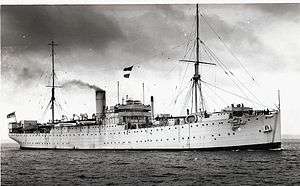HMS Cyclops (F31)
 HMS Cyclops off the Isle of Bute, circa 1943 | |
| History | |
|---|---|
| Name: | HMS Cyclops |
| Builder: | Sir James Laing & Son (Sunderland, U.K.) |
| Launched: | 27 October 1905 |
| Commissioned: | 5 November 1907 |
| Nickname(s): | Cycle Box |
| Fate: | Scrapped in 1947 |
| General characteristics | |
| Displacement: | 11,300 long tons (11,500 t) |
| Length: | 145.1 m (476 ft 1 in) o/a |
| Beam: | 16.8 m (55 ft 1 in) |
| Draught: | 2.51 m (8 ft 3 in) |
| Propulsion: | Triple Expansion Engines = 1100 indicated horse power |
| Speed: |
|
| Complement: | 266 |
| Armament: | Two 4 inch MkV naval guns |
HMS Cyclops (F31) was a submarine repair and depot ship of the Royal Navy. She was originally the passenger liner Indrabarah sister ship to Indralema, built by Laing, for the Indra Line Ltd then bought by The Admiralty, while she was building. She was launched 27 October 1905.
Cyclops was 460 feet (140.2 m) long between perpendiculars and 476 feet (145.1 m) overall, with a beam of 55 feet (16.8 m).[1] See also HMS Titania.
Career
Cyclops served during the First World War as a repair ship with the Grand Fleet where she served the whole of the War at Scapa Flow.[2] She was paid off 1 April 1919, then was recommissioned for White Sea duty at Archangel. She returned to Chatham in October 1919 and on 31 January 1920 went into reserve for refit and conversion to a submarine depot ship, commissioning for the 1st Submarine Flotilla , Atlantic Fleet, on 21 December 1922 at Chatham Dockyard.
Between the wars HMS Cyclops served in Malta and was in reserve at the start of the Second World War before returning to Home Waters in late 1939 as the depot ship for the Royal Navy's 7th Submarine Flotilla based in Rothesay
Between November 1939 and May 1940 "Cyclops" was the depot ship for the 3rd Submarine Flotilla, based at Parkeston Quay, Harwich Harbour. Her 6 S-class submarines reconnoitred and raided in the Heligoland Bight and off Denmark. She was nicknamed "Cycle Box". In December 1939 she used her 4-inch guns to engage a German seaplane attacking the harbour.
On 6 May 1942, HMS H 28 (Lt. R.E. Boddington, RN), HMS H 32 (Lt. J. Whitton, RN), HMS P 614 (Lt. D.J. Beckley, RN) conducted practice attacks on a convoy made up of the submarine tenders HMS Cyclops (Capt. R.L.M. Edwards, RN), HMS Titania (Cdr. H.R. Conway, RN) and their escort HMS Breda (Capt.(Retd.) A. E. Johnston, RN), HMS La Capricieuse (Lt.Cdr. G.W. Dobson, RNR) and HMS Boarhound (formerly HMS Terje 2 (FY315), renamed on 19 Jan 1941) (Skr. S.G. Jinks, RNR).
In 1944 she sailed from Rothesay to Singapore via India and returned to the UK in 1946.
Facilities
Cyclops was well served with a distilling plant for fresh water, machinery, carpenters' and blacksmiths' shops, coppersmiths', iron, and brass foundrys.
Commanders
| Name | From | To |
|---|---|---|
| Capt. Philip Ruck-Keene, RN | 15 Nov 1939 | 27 May 1940 |
| A/Capt. Edward Henry Longsdon RN | 27 May 1940 | 11 Jul 1940 |
| A/Capt. Roderick Latimer Mackenzie Edwards RN | 11 Jul 1940 | 5 Apr 1943 |
| A/Capt. Cdr. Harold Robson Conway, RN | 5 Apr 1943 | 30 Oct 1944 |
| Cdr. Benjamin Bryant DSO, DSC, RN, | 30 Oct 1944 | 4 Feb 1945 |
| A/Capt. David Caldicott Ingram, DSC, OBE, RN | 5 Feb 1945 | 1946 |
Fate
Cyclops was sold to John Cashmore Ltd and scrapped at Newport in July 1947.
See also
References
Publications
- Colledge, J. J.; Warlow, Ben (2006) [1969]. Ships of the Royal Navy: The Complete Record of all Fighting Ships of the Royal Navy (Rev. ed.). London: Chatham Publishing. ISBN 978-1-86176-281-8. OCLC 67375475.
- Dittmar, F.J.; Colledge, J.J. (1972). British Warships 1914–1919. Shepperton, UK: Ian Allan. ISBN 0-7110-0380-7.
- "H.M.S. Cyclops, Floating Repair Shop for the Navy" (PDF). The Engineer. 108: 77–79. 23 July 1909.
- J P Foynes "The Battle of the East Coast 1939-1945" and "Who was to Blame for the Loss of HMS Gipsy".
- G W G Simpson "Periscope View".
External links
| Wikimedia Commons has media related to HMS Cyclops (F31). |
- Nautical History and Art - Adventures of the Blackgang
- Naval Historical Collectors & Research Association NHCRA - The Story of one of the Navy's Repair & Depot Ships
- HMS Cyclops at battleships-cruisers.co.uk
- The role played by HMS Cyclops and her flotilla of submarines Isle of Bute during World War II